As I write this, I am sitting at the desk with a hankie tucked into a clear eye patch over my right eye. I had eye surgery this past week, and while I appreciate the fact that they are able to fix the hole in my macula, I am already sick and tired of seeing half the world in full blur. Covering that eye up seemed like a good option for a while, so I would quit trying to use it. The summer intern has pointed out that I look like the most pathetic pirate ever. Honest, I picked a pretty hankie! I meant to write this before I had the surgery, but you know how that goes, so I will do my best to write it now and give thanks to the Grammar Guru in advance for all the corrections he will be forced to make.
I was carefully hiding, I mean placing my latest acquisition in a drawer a couple of weeks ago, when I said, hey, this would be a fun thing to write a post about, so here goes. (Oh, and dear hubby really does know about this collection, but I used to hide it, and old habits die hard. He actually found the latest one.)
For a lot of folks this photo is going to mean absolutely nothing. For some they will have remembered seeing something like this at Grandma’s house. Well Grandma and everyone else used to have several of these at all times. What are they? Flower Frogs. Why a frog? General consensus is that no one knows for sure, but maybe because they hunker down in water like a frog. These little spiny metal beasts measure between half an inch and over three inches long. (The tiniest one is the newest one.) They were placed in the bottom of pots and vases for flower arranging. They reached their height in popularity during the ’20s and ’30s but were still in wide use till the ’60s. You can even buy new ones today. Most of them have a very heavy base, although there are lighter ones that were secured with floral putty.
I first learned about these when taking a flower arranging class. Decided I needed one, and scoured garage sales till I found a couple. They were perfect for my class and kind of fun to use. Well, you know our motto: one of anything is the start of a collection, and there I went. I have quite a few variations of the ones in the first photo. Different shapes and sizes, then I came upon these:
These were designed to be put together in different shapes to fit your vases better. The triangle shape one still has its box!
Here are some later examples of the pin type holders. These were designed to hold a bit of water too, and were specifically designed for Ikibana:
They didn’t hold a whole lot of water, so the arrangements would have been fleeting, but hey, they were cool, so I needed some of those too!
Here is another basic form:
These cage type holders worked a bit better, as they didn’t rely on piercing the stem to hold up the flowers. Many designers just used a wadded up piece of chicken wire to do the same thing, but where is fun in that?
I loved that this one took care of holding itself in place in your vase:
Not that the suction cup on this has held anything but dust for several decades, but they tried. I really bet that if you had relied on this holding up a bunch of sunflowers, your bouquet would have come crashing down, even when it was brand new.
Here is one of the pin type ones still in the packaging:
The packaging looks to date to the ’40s or so, and here is the back:
There you go, how to arrange flowers in one easy lesson. Viola! You are an expert!
Now we come to some of the odder types. I like these hairpin ones:
Another solution that doesn’t rely on a pin sticking into a stem. These are much better for the softer stemmed flowers. And here again, one still in its original packaging with the instructions. No flower arranging expertise here; you were on you own. The number of these that show up in original wrappers is a testament to the basic housewife’s amount of free time to dedicate to flower arranging!
Now we come to some favorites, at least for ones to actually use.
I really use the large ones with loops on them occasionally. They are perfect for tulips and daffodils, and make it so if you just have a few, they still sit gracefully in a vase or pot. The one in front is another of the hairpin styles, but a pretty small one. It’s only about an inch across.
Not content with the utilitarian frogs, lots of companies made them out of glass:
A few more folks might be familiar with this style, and it shows up as “What is it?” fairly often. A lot of marble collectors love these to display their collections on. The yellow one is uranium glass and the black amethyst one (all old black glass is purple if you hold it up to the sun!) has a base to hold water. The clear one is the most common.
And if that doesn’t take the cake, my favorite of all time, Frog frogs:
Pottery frogs were made in all sorts of shapes and styles. Many to match a pot or large saucer type container, but I am not happy unless it’s a frog shaped like a frog. The mushroom one in back has a frog on it, so it counts. Here are the bottoms of these, for the pottery geeks:
The dark green is probably an unmarked early Weller, the mushroom is a marked Weller and the rose colored one is a Van Briggle from the ’30s or ’40s. The one in front on the top picture is newer and not marked.
The best part of collecting these are the prices. You can pick up lots of the pin types ones for less than a buck, and heck, they even land in the free box now and then because no one knows what they are! The glass ones run $5 to $10; try to pay less. All bets are off on the pottery ones, if they are marked, although art pottery has come down drastically in recent years. Enough that the Weller mushroom used to be worth $45 to $50, and now can be had in the $20 neighborhood, depending on the dealer. And hey, they are even useful. Give it a try, and if you ever find a frog frog, you know who to call!
Oh, on a final note, due to overwhelming support, the thermo-spoon will continue to live with me. Thanks for validating my craziness:

















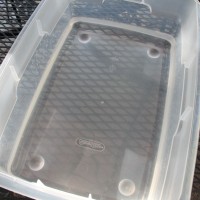
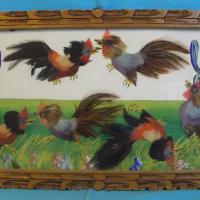
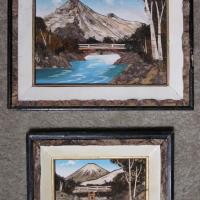
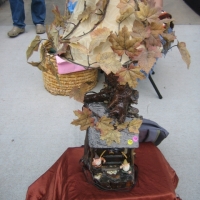



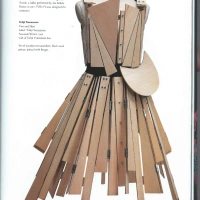

Great informative post. I have lots of ‘frogs’ in different styles and patterns I bought in the 60’s and 70’s. They are definitely collectible and your art pottery ones are FAB! Hugs, Sandi
So glad you enjoyed it, Sandi. Frogs are near and dear to Kathy’s heart; she is always on the lookout for them and really excited when she finds a different style. Those pottery ones are wonderful and hard to find! We have tons of collections so if there is something you would like us to write about, speak up!! Hugs, Deb
That was so much fun – what a great collection! I only have two of these – a metal cage version that I thought was some sort of plumbing fixture, but that I use for holding feathers, and one nice ceramic one that I rec’d in a holiday swap. It’s very attractive and I have used it for close cut roses.
I hope you will be back to full vision very soon!
Thanks Steph, the eye should be mostly normal in a few weeks, I muddle through. Glad to solve the mystery of the metal cage flower frog, and I can see why you thought it might pertain to plumbing.
Thanks for the good wishes and the nice comment. It’s a very different collection, and a couple of the frogs are really odd looking if you don’t know what they are. A feather display is a great idea for using a frog. I think they also work if you want to display hat pins in a vase. When you have a bunch, you have to get creative with their use. Hugs, Kathy and Deb